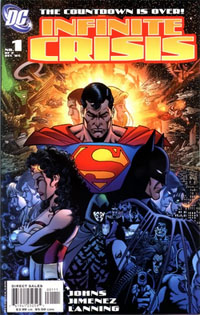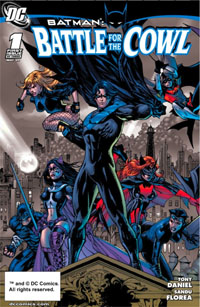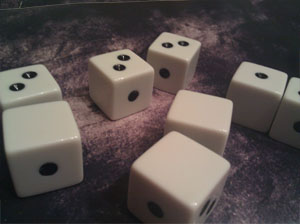 Step 1: I have just read some interesting things about recent DC continuity and would like to check it out.
Step 1: I have just read some interesting things about recent DC continuity and would like to check it out.
Step 2: Let’s try Infinite Crisis.
Step 3: Ah, there’s a Countdown to Infinite Crisis. I should read that first.
Step 4: Hmm… Apparently this ties into a bunch of mini-series leading up to Infinite Crisis. Some googling reveals The OMAC Project, Rann-Thanagar War, Days of Vengeance, Villains United, and The Return of Donna Troy.
Step 5: And some more googling tells me what order I should read them in. Also, I seem to have missed a Prelude to Infinite Crisis…
Step 6: … and these mini-series wrap-up in several specials. When should I read those?
Step 7: Oh. Intermixed semi-randomly between the seven issues of Infinite Crisis.
Step 8: Okay, now I can start reading.
Step 9: Three issues into The OMAC Project and apparently the “story continues” with Superman: Sacrifice. Can I just skip that and keep reading this series? … Nope. Nothing makes sense. (In fact, it turns out that Superman: Sacrifice contains the event which arguably triggers the entire Infinite Crisis.)
Step 10: … and Superman: Sacrifice is split across three different Superman comics and a random issue of Wonder Woman.
Step 11: Okay. Tracked those down. I’ll continue reading…
Step 12: And then Infinite Crisis sucked.
(Some of the mini-series were pretty decent, though.)
Why is DC Comics asking me to do this much homework in order to simply read their books?
Admittedly, only some of this material was actually crucial for understanding and appreciating Infinite Crisis (insofar as that drek could appreciated on any level). But that doesn’t actually help, because I had absolutely no way of figuring out which bits weren’t essential until after I’d read them. (And it’s not as if I tried to seek out every issue of DC that crossed over with Infinite Crisis. These are just the major backbones of the event.)
If Marvel and DC really feel it’s important to create this kind of convoluted, multi-title, overlapping continuity, I say more power to them. But, if so, then it would really behoove them to put together reading lists so that readers who are interested in their comics can trivially figure out what they need to read.
Having cleared Infinite Crisis, I proceeded to 52 — which was delightfully straight-forward, except for the bit where you read issues #1 thru #50, then stop and read World War III #1-4, before finishing with 52 #51-52. (This problem, at least, is cleared up in the collections.)
But now I’m trying to figure out Countdown to Final Crisis and, as far as I can tell, it is literally impossible to put together a reading order for its penumbra of narrative. (In fact, all I can find online are people saying, “I dunno.”)
Below the “Read More” barrier, however, I have included my reading order for the first chunk of the modern crisis era at DC Comics (for anyone who might find it useful). I have included my personal grades for each story in parentheses after each title.
(more…)
 You know the story I never need to read again? It’s the one where some vigilante comes to Gotham City and says, “I’m going to use guns and kill criminals. ‘Cause I’m a bad-ass and I’ve got the guts to do what Batman can’t.” And then, ya know, something goes wrong: A kid or a cop gets caught in the crossfire. It turns out the “criminal” was actually innocent. Commissioner Gordon won’t stand for it. Batman says, “Stop being a dick.” Whatever.
You know the story I never need to read again? It’s the one where some vigilante comes to Gotham City and says, “I’m going to use guns and kill criminals. ‘Cause I’m a bad-ass and I’ve got the guts to do what Batman can’t.” And then, ya know, something goes wrong: A kid or a cop gets caught in the crossfire. It turns out the “criminal” was actually innocent. Commissioner Gordon won’t stand for it. Batman says, “Stop being a dick.” Whatever.












